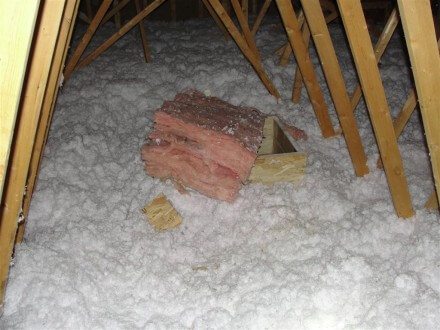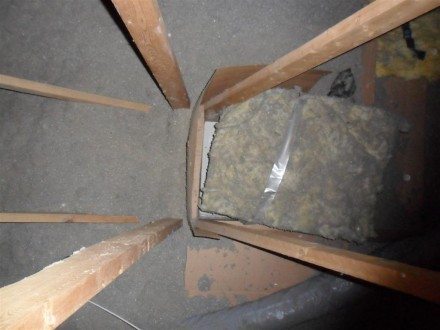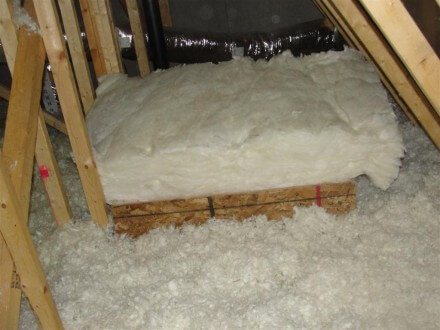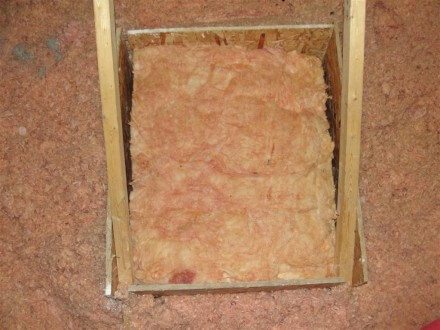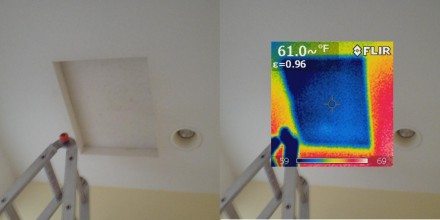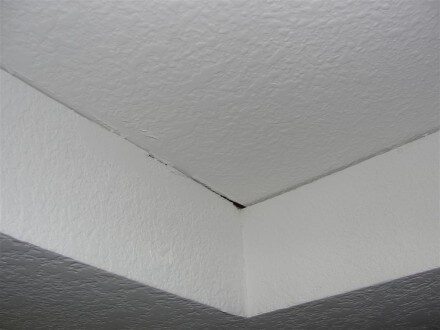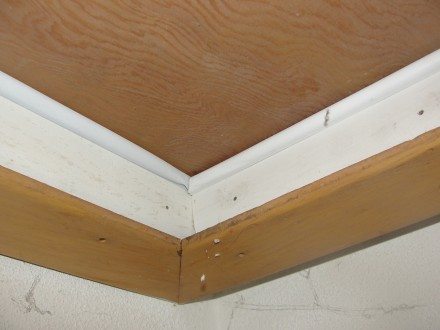For at least the last twenty years or so, the most common way of insulating attics in Minnesota is to use loose-fill insulation – either cellulose or fiberglass. This is a huge improvement over fiberglass batts, because batts are nearly impossible to install in attics and they cost more money. Despite the decline of fiberglass batts in attics, I still find a small section of fiberglass batting used above the attic access panel at about 90% of the homes that I inspect, even on new construction.
For the fiberglass batt to insulate the scuttle hole effectively, it needs to fill the entire space and be in significant contact with all four sides of the wood ‘dam’ that is built inside the attic for the access panel to slide up through. When the insulation piece is too small, it doesn’t touch all four sides and allows for heat loss. When the insulation piece is properly sized, it works fine, but the insulation won’t drop in to place inside the dam. It needs to be pushed in to place. To do this, the insulation needs to be installed from the attic side.
How is the homeowner (or home inspector) supposed to be able to do that? It’s impossible unless there are two ways of getting in to the attic. When there are two ways of getting in to the attic, it’s usually because the average person can’t climb from one section of the attic to the other. I’m an above-average climber, and I’ve climbed through plenty enough attics to see what those fiberglass batts look like on the other side. They’re almost never right. The photos below show a few recent examples; either the batts aren’t pushed down inside the dams, they’re too large, or they’re too small.
When the fiberglass insulation above the attic access panel doesn’t get installed properly, the home experiences unnecessary heat loss at this location, which you can clearly see in the infrared image below. This isn’t an unusual installation; this is typical of attic access panels that are insulated with fiberglass batts that are too large.
If you want to know how well your attic access panel is insulated, climb up in to your attic and have another person drop the attic access panel down behind you. You’ll probably see something very similar to the photos above.
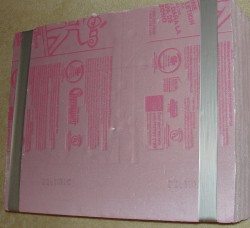 I’ve found two solutions that seem to work pretty well. One is to have the panel re-insulated with something other than a tight-fitting fiberglass batt, such as rigid foam boards that fit the attic scuttle hole perfectly. Easier said than done, but it’s probably the best method I’ve seen. In a perfect world, it would fit so tight that the panel had to be pulled down in place with two handles attached to the cover… but most people wouldn’t go for that look. I took a shot at building my own by cutting four pieces of rigid foam to size, gluing them together with 3M spray adhesive, and then duct taping them together for good measure. It looked about as pathetic as my home-made recessed light cover, but too bad. I’m the only one who will ever know.
I’ve found two solutions that seem to work pretty well. One is to have the panel re-insulated with something other than a tight-fitting fiberglass batt, such as rigid foam boards that fit the attic scuttle hole perfectly. Easier said than done, but it’s probably the best method I’ve seen. In a perfect world, it would fit so tight that the panel had to be pulled down in place with two handles attached to the cover… but most people wouldn’t go for that look. I took a shot at building my own by cutting four pieces of rigid foam to size, gluing them together with 3M spray adhesive, and then duct taping them together for good measure. It looked about as pathetic as my home-made recessed light cover, but too bad. I’m the only one who will ever know.
Another solution I’ve found is to use a fiberglass batt that’s slightly too large, and attach it to two or three pieces drywall that covers the scuttle hole. This makes the cover so heavy that it’s quite a chore to push it up in to the attic, but it also helps the panel fall down in to place, pulling the insulation down with itself.
The other common issue I find with attic access panels is that they’re not airtight. This is much more of an issue with old houses than it is with new houses, but I still find my share of new construction homes with poorly sealed panels, such as the one shown below at a new construction inspection in Farmington.
One way to make the attic access panel airtight would be to caulk it shut, but I hesitate to do that because the attic is supposed to be accessible. A much better option would be to install weatherstripping around the panel, but if the access panel is located in a commonly used hallway, I can understand why homeowners wouldn’t want to do this: it’s ugly. I rarely find weatherstripping installed unless the access panel is located in an out-of-the-way closet.
If you want to know if your access panel is airtight, just waft some smoke around the panel edges. If it’s leaking, you’ll see air movement here. While air leaks at the lower levels create cold drafts, you usually don’t feel them at the attic access panel because it’s air leaving the house, not coming back in.
If you have a great attic access panel insulation method that doesn’t look hideous and you’d like to share it, please send it to me. I’d be happy to share it with others.
Reuben Saltzman, Structure Tech Home Inspections – Email – Minneapolis Home Inspector

